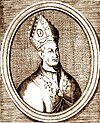Philippe de Cabassoles: Difference between revisions
added 1376 picture of Petrarch |
expanded article a little |
||
| Line 30: | Line 30: | ||
== Early life== |
== Early life== |
||
Philippe was born into a noble Provencal family connected with the House of Anjou, in whose [[diocese]] was Vaucluse. |
Philippe was born into a noble Provencal family connected with the House of Anjou, in whose [[diocese]] was Vaucluse. |
||
Philippe was made Canon of the cathedral chapter of Cavaillon on March 22, 1328. |
|||
He next was promoted to [[archdeacon]] on August 26, 1330. He then took a position as [[Provost (religion)|provost]] on September 18, 1331. Philippe was promoted to the [[episcopate]] when he was a [[deacon]] |
|||
== Middle life == |
== Middle life == |
||
Revision as of 16:03, 3 October 2011
You can help expand this article with text translated from the corresponding article in French. (January 2010) Click [show] for important translation instructions.
|
Philippe de Cabassoles | |
|---|---|
 | |
| Born | 1305 Avignon Cavaillon, France |
| Died | August 27, 1372 |
| Other names | Cardinal of Jerusalem |
| Parent | father: Isnard de Cabassole |
| Ordained | 1317 |
Offices held | Bishop of Cavaillon Cardinal Priest of Saints Peter and Marcellinus Cardinal Bishop of Sabina (1368-1372) |
| Title | Canon of the cathedral chapter of Cavaillon |

Philippe de Cabassole or Cabassoles (1305-1372), the Bishop of Cavaillon, Seigneur of Vaucluse, was the great protector of Renaissance poet Francesco Petrarch.[1]
Early life
Philippe was born into a noble Provencal family connected with the House of Anjou, in whose diocese was Vaucluse. Philippe was made Canon of the cathedral chapter of Cavaillon on March 22, 1328. He next was promoted to archdeacon on August 26, 1330. He then took a position as provost on September 18, 1331. Philippe was promoted to the episcopate when he was a deacon
Middle life
Philippe had a villa not far from Avignon.
The best friend of Petrarch
Philippe formed a lasting friendship with Petrarch since 1337.[2] Petrarch built a home in Vaucluse after visiting his friend Philippe, who had built his castle on the site of a 7th century BC Oppidem. From Philippe's castle the view was beautiful and is no wonder the bishop selected this lofty spot. Living just a short twenty minute walk from one another, they developed a very close relationship that lasted a lifetime. Petrarch dedicated a book to his friend, who "treated him as a brother", despite his later status as Cardinal. Among the intimates of Petrarch's old age there seems to be only one name missing in Petrarch's will, which is Philippe's. Their friendship had begun in 1337 when Petrarch moved to Vaucluse. They stayed close friends up until Philippe's death in 1372.[3] The fact that in spite of this undoubtedly very close relationship Petrarch did not include his friend Philippe in his Last Will and Testament is explained by the assumption that Petrarch could not think of any bequest suitable to a man of such high status as that of a prince.[4]

Petrarch made a collection of 350 letters he personally wrote called Epistolae familiares (a.k.a. Familiar Letters). In among these letters in 1346 Petrarch writes what is called De vita solitaria, a treatise composed of two books and dedicated to Philippe de Cabassoles.[5] In Book XXII of Familiar Letters is Petrarch's books of these letters to Philippe which he delivered 20 years after he wrote them.[6][7] Also in addition to these books of letters he wrote some very special letters that he held out of the set of Epistolae familiares, which was later put into a set of 19 letters called Liber sine nomine. Letters 1 and 12 are letters Petrarch wrote to his friend Phillippe that are in this reserved set of letters "without a name" of the recipient.
References
- Calthrop Hollway-Calthrop, Henry, Petrarch: his life and times, G.P. Putnam's sons, 1907
- This article incorporates text from the old Catholic Encyclopedia of 1914, a publication now in the public domain.
- This article incorporates text from the Schaff-Herzog Encyclopedia of Religious Knowledge, a publication now in the public domain.
Footnotes
- ^ Calthrop Hollway-Calthrop, pp. 83-84
- ^ Catholic Encyclopedia, "Archdiocese of Avignon."
- ^ On Philippe de Cabassoles see Martellotti's introductory remarks in his edition and Italian translation of "De Vita Solitaria" in Petrarca, Prose, page 286.
- ^ Petrarch's Last Will: A Personal Document of his Old Age introduction pages 20 through 22 by Theodor E. Mommesen, Cornell University Press, 1957.
- ^ Familiar Letters - XI, XII, XV, XXII, and XXIV letters to Philippe.
- ^ Hermitary - resources and reflections on hermits and solitude.
- ^ Some short extracts from Petrarch’s Life of Solitude, written to Philippe
